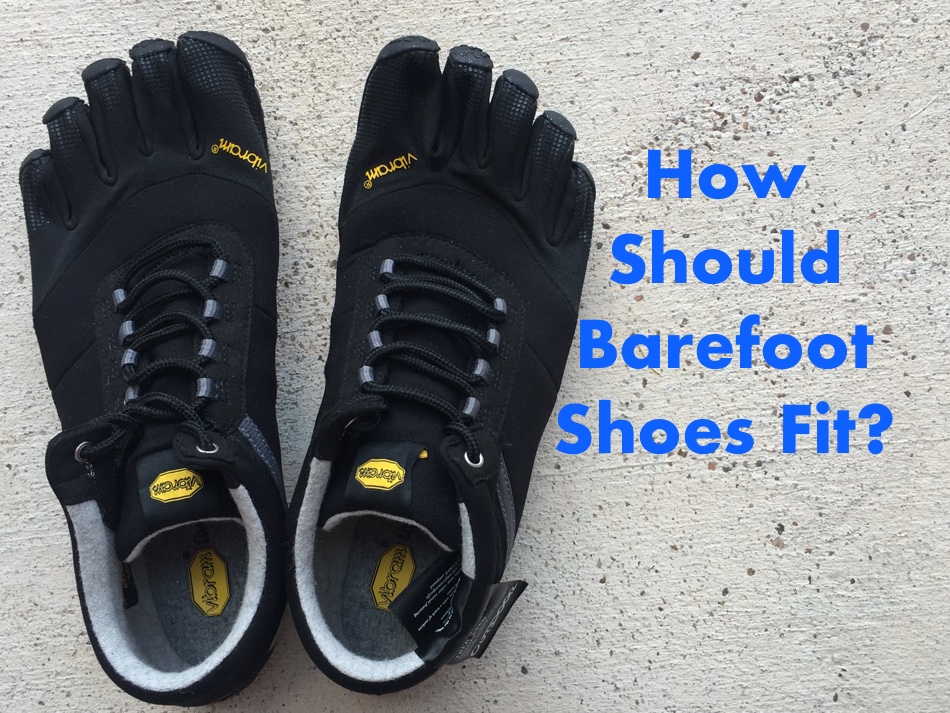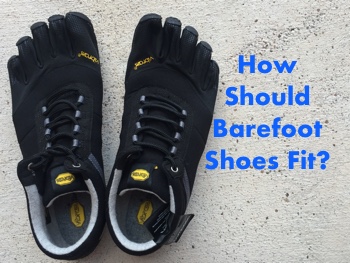
They should fit like a glove
How Should Barefoot Shoes Fit?
Table of Contents
So its time now for you to buy your next pair of training shoes and you have decided to go the way of the “barefoot” One of the most common questions I get when I’m out in my Vibram Five fingers especially is; are they comfortable? To which I always reply.. ‘yes they are’. I may then take a moment to effuse the virtues of the shoes and all things barefoot, but sometimes not.
Getting the barefoot shoe that fits you perfectly is an opportunity to take a different approach to shoe fitting in general. How should barefoot shoes fit? Barefoot shoes should fit like a glove. Think foot size not shoe size, shoes are made all over the world and fitting by shoe size can be misleading. A good fit allows the natural expansion of the foot on ground contact. This enables the foot’s natural motion, allowing it to move and work naturally.
Can your toes wiggle freely in the shoe?
Always get the shoes and try them on for fit first. Head to a store and try them on, so you can get a good sense of what they feel and look like. Another option could be that you can also order more than one pair from an online store. Most stores have an excellent returns policy so swapping out and returning stuff should be relatively pain-free.
Let go into more detail and have a look at all the things to think about getting the Barefoot shoes fit just right.
Try the barefoot shoes on for fit and comfort forget the thought of shoe size.
Barefoot Shoe Types
We have two basic types of barefoot shoes
- Barefoot shoes with no toe box like the five fingers
- Barefoot/Minimalist shoes with a toe box and zero drop heel
Barefoot Shoe
These give you the nearest feel to going truly barefoot. With these type of shoes, you get minimum protective covering underfoot from anything that may hurt your feet on the ground. Many have a tiny bit of cushioning on the heel but its nothing much compared to the traditional running shoes you may be used to. The amount of cushioning you get will be shoe, model and manufacturer dependent.
Example of a barefoot shoe include the Vibram five fingers check out mine here
Minimalist Shoe
These give you the best of both worlds; they are a blend of barefoot shoes and traditional running shoes. Like traditional running shoes, they have a toebox, but with these shoes, the toe boxes are much wider giving your toes the much-needed wiggle room. They are a good way to ease into barefoot running. Typically they have lightweight construction, little arch support and very little hell drop.
How To Get The Right Fit
In getting the right shoe size, I have found that taking the conventional approach of going by your previous shoe size can be a bit misleading. Here are some simple steps to get you sorted.
Don’t Measure Your Feet In Shoe size
Try the shoes on for fit get into the store and follow as many of these tips as you can to get a shoe fit you are happy with.
The simplest way to do this is to measure your feet in cm in inches
- Place your heel against a wall with your foot flat on the ground.
- Us a ruler on the side of your foot and take the longest measurement.
- Do the same for the second foot.
- The longest measurement will be your starting point for your size chart
For five fingers it a little different.
- Lead with the big toe first, getting that fitted and in place and the other toes will follow easier.
- It will feel a bit strange the first time you do it but believe it, or not your toes will get used to it.
- Fasten up the Vibrams, wiggle your feet and get a sense of how they feel.
- Bounce on you for foot and get a sense of how they fell. They should not be too tight but hold your feet snugly.
- Do some squats and walk on tiptoes too, with both shoes on.
One they feel snug and comfortable. You have probably got the right pair.
Barefoot Sizing Tips
- The best time of day to try shoes on is at the end of the day. This is when they are probably the most swollen
- Go For a run in them if you can. Don’t just wear them in the store if you want a good fit.
- For women consider trying a men’s pair of shoes so you can get a wider toes box.
- Make sure you try both shoes on. We don’t realise that both feet are seldom identical.
- Don’t go by your previous shoe size. If you do use it purely as a starting point. Be prepared to go bigger or smaller.
- Move up in shoe sizes in half sizes till you get the perfect fit.
- Go for the fitting with the type of sock you would typically use for your barefoot activity.
- Seek out a hard surface to test the fit on, not a carpeted one. This will give you a better send of feel, and you will be typically walking outdoors anyway.
- Do not tighten lace too much. Allow midfoot and forefoot to be relaxed and comfortable.
- If you are going to run in your barefoot shoes, then you must go for a run in them. Get to know first hand how they feel. This will save you a lot of hassle trying to deal with avoidable discomfort and possible injuries.
Think About Socks?
Even though socks are not necessary and are mainly for comfort and avoiding blisters try the shoes on with them as I said earlier. Use a sock type similar to ones you would normally run or lift with.
Fitting of barefoot or tradition sock can also be too tight so make sure they are comfortable. I tend to use socks occasionally sand I have found the barefoot Injinji’s to be quite good. I did a write up check it out here
Sock Style and length can vary from all the way up to the top of the claves to below the ankles almost invisible. The materials range from manmade blends, cotton mixes to my favourite merino wool.
Qualities Of The Perfect Barefoot Shoe
- Lightweight and flexible: They should have a lightweight construction so they are as easy to clean and to carry around. More importantly, your feet will have the freedom to move as nature intended, in a multitude of directions.
- Zero Drop Heels: Little or no elevation on the heels is optimal. All that is required is a minimal amount of cushioning underfoot. The most amount of impact should be on the forefoot and not on the heel.
- Wide Toe Box: This gives the big toe the chance to work as intended and keep your body alignment correct and you in a good state of balance.
- Thin soles: The thinner the sole and closer to the ground the better. This way you will get more ground feel and a better sense of balance. Your body will respond to the connection with the ground and will aid your movement patterns better if you have a more connected feel of the ground.
Wrap Up
Getting the right fit on a barefoot pair of shoes is a simple enough endeavour especially since you now know what to look for. Take an open-minded and relaxed approach letting go the usual manner you have bought shoes in the past.
The best way is to go to the store if you can and get to touch the shoes yourself. In most cases, however, I find that few store stock a full range of barefoot shoes for you to go in and try. This leaves us with the next best option which is to go online as I said earlier and getting a few pairs ordered.
If you use the heel against the way trick I mentioned, then it will be easier to match your measurement against the size chart.
So Remember:
- Decide the Barefoot shoe type: Barefoot or Minimalist
- Decide on socks: Try with the same type of sock you would normally use for running or training.
- Fit in store if you can.
- Use foot length, not shoe size as a guide: use the tips above to get a good idea and compare to the size charts you will use to buy. Since they vary, this is a good way to do it.
- Order multiple shoes online so you can try for the perfect fit.
- Aim for a snug comfortable fit.
- Bounce and move around on a hard surface once you have them on.
- Go for a run if you can if you intend to use them for running.
Enjoy the journey to getting a good fitting Barefoot shoe. I have been them for years, and they are the best things ever.
